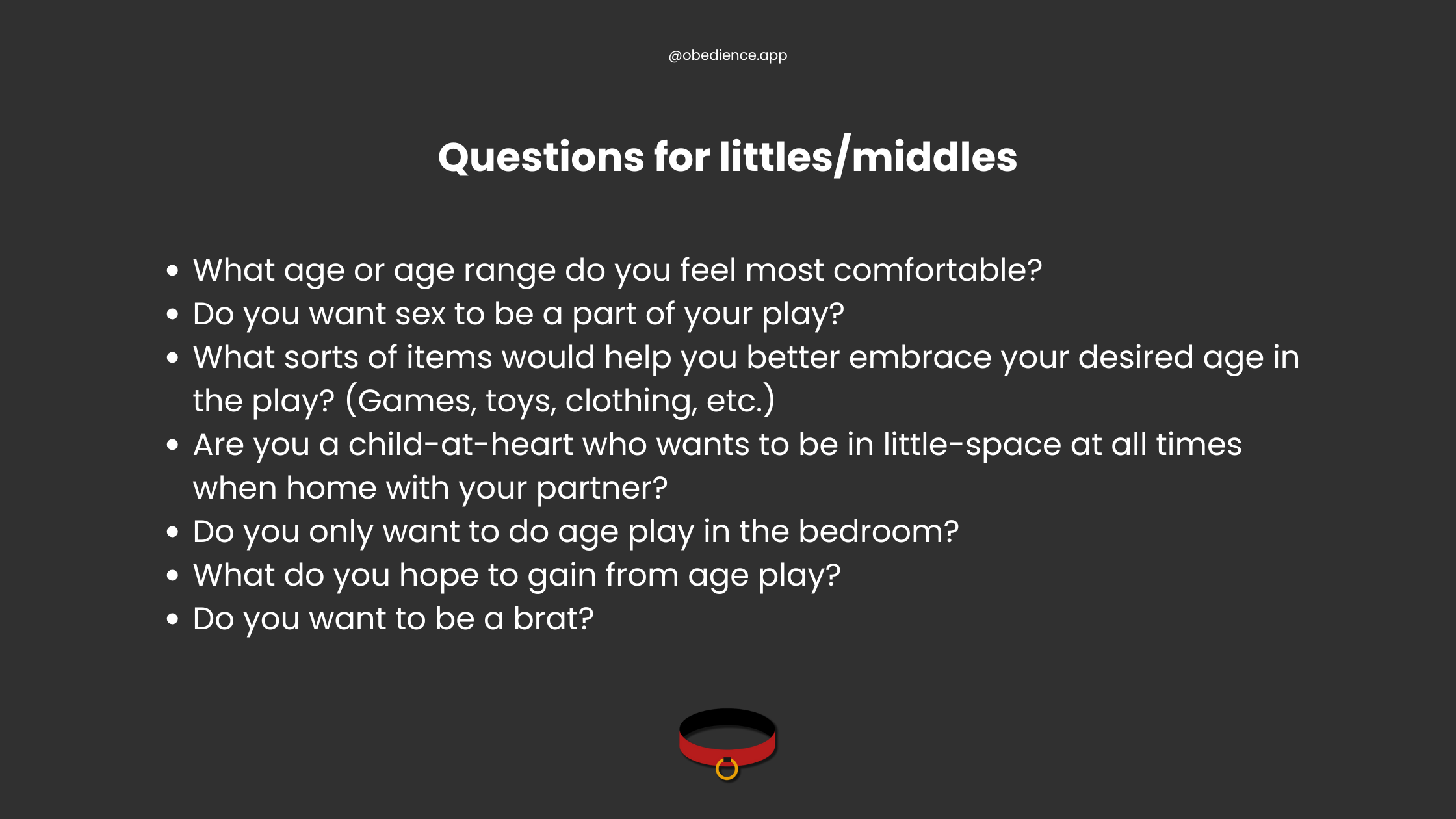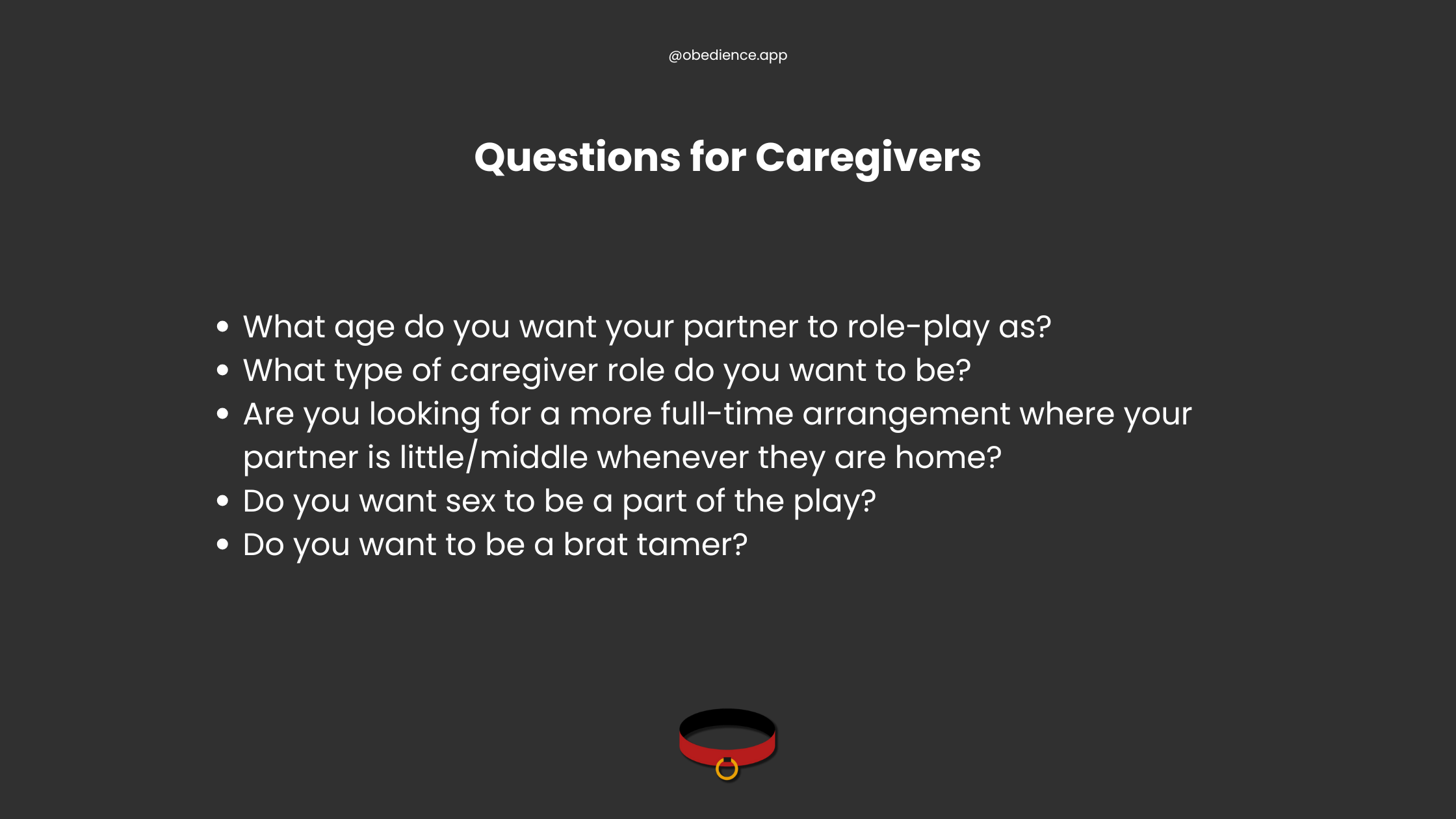Age Play 101: Roles, Safety and Controversies
written by Micah Brown
Let’s get the elephant in the room addressed right up front: It’s okay to be aroused by age play. In fact, many people take part in age play without realizing what they are doing. The couple who dons the Cheerleader Uniform while the other partner plays the Coach are absolutely taking part in age play, and that’s okay.
Perhaps the most important thing to remember about age play is this: Age play is role-play that occurs between consenting adults.
Many folks in the vanilla world believe that it is simply a stand-in for more nefarious activities. This is simply not true. Psychology Today reiterates that people who participate in age play are adults who want to play with other adults, and they are not the same as those who are actually attracted to children. It should also be noted that not all age play is sexual and that a large subset of littles do not want any kind of sexual activity when they are in little space.
With that out of the way, let’s delve into age play, what it is, what it isn’t, and how many people may partake in it without realizing that’s what they’re doing.
Age Play and Roles
There are a number of different dynamics that emerge when looking into age play. It’s important to remember that not everybody is going to be the same. There are generally three subsets of ages that those who play younger will likely fall into:
Adult Baby: Infant to toddler age - this may include diaper play, bottles, changing, and so forth
Littles: Generally pre-school to elementary school aged play
Middles: These people play as tweens and young teens
When it comes to the person who is playing the role of the caregiver/adult to the age player, we see a variety of roles available for them:
Mommy/Daddy/Caregiver: Taking on the role of a parent or caregiver to the individual who is playing younger
Mommy/Daddy Dom: We again see a caregiver role here, but we move into a more BDSM coded dynamic where the more corporeal forms of punishment may be a part of the play.
Other Roles: When it comes to scenes, you can have any role of somebody who is a position of power, like teacher, photographer, babysitter, coach, and so forth.
Of course, these are just the basics of the roles an age player may take part in.
Another potential role that should be discussed is that of the Brat. A brat is an individual who likes to be contrary to their Dom often in the hopes of earning a “funishment.” Of note, a brat does not have to be an age player, but they are most often associated with those who do age play, generally in the middle space.
Age Play and Safety
Outside of the regular safety nets you should be using for any type of BDSM play, there are some additional caveats that should be made for those who participate in age play.
Online Safety
For example, with the advent of online play, a new layer of complexity arises when attempting to do age play over the internet. The safety, in this case, is more for the partner who is looking for somebody to role-play younger. There are several reasons why one needs to be careful when attempting to find age play partners online, and one of the top reasons is going to be law enforcement.
Yes, age play is legal because it’s between consenting adults, but if you are chatting up somebody online and you’re not verifying their real, chronological age, this can end up getting you into buckets of hot water. Law enforcement frequently poses as younger people online in order to capture online predators who want to meet with actual children, and they have arrested age players in the past. When playing online, make certain that you are able to verify the ages of those with whom you might like to play.
One way to remain safe in that regard is to join kink-friendly communities that verify age before allowing people to join. You can find these communities on FetLife, Discord, and other social media platforms. Meeting somebody through these sorts of platforms will help keep you safe online.
Safe Play
As with all forms of kinky play, it’s good to sit down before any scene and discuss the parameters of the scene. For those who enjoy diaper play, discussing what level of diaper play is going to involved in a scene is very important for the caregiver role to know. While sexual play with littles isn’t always the goal of the little, there are times when such sexual play may occur and understanding what the limits to play are and what the expectations are for that play will be just as important. Taking advantage of somebody in little space is just as bad as taking advantage of somebody in sub space. Negotiate all aspects of what the scene will entail and do not try to renegotiate once the person has gone into little or middle space.
Make certain you have a safe word. Even if there’s not bondage, spanking, or any other types of hard play, you still want to have a safe word ready for use in the event that something becomes uncomfortable for either party.
Maybe a little wants to explore sexual play with their caregiver, but as the caregiver gets further into the sex play, the caregiver realizes they are uncomfortable with the idea and can then use a safe word to stop the play. As a reminder, safe words are for everybody in a scene.
Mental Health
Disclaimer: age regression is, in most cases, a symptom of mental health issues like BPD or C-PTSD. It is not sexual and should not be sexualised.
The psychology of age play is something that has been studied for those who enjoy little/middle play, like adult babies and littles. Some research has shown that many of these individuals feel more natural in a childlike state and spend their time in the real world trying to act like an adult. When they get home to their caregiver, they may “go smol” to a more playful and childlike state. For littles, this may be playing with children’s toys, reading story books, coloring, or other such activities.
Why somebody may feel more childlike or why they want to “go little” could have many layers. It can range from wanting to experience a trauma-free childhood to wanting to escape the responsibilities of adulthood and live again as a child who has no worries except what toys to play with or what cartoons to watch.
There is a distinct difference in how littles and middles act when they are in the headspace in these ways, which is entirely built along the interests and performative age of the individual. A little may play with dolls, while a middle may be more interested in chapter books or teen dramas on television.
Psychologists largely agree that regression isn’t something to be concerned about and, in many cases, is healthy for the individual who experiences it.
Despite the term “play” being a part of age play, many find their little personalities to be a closer representation of who they are on the inside, and take it all very seriously in an attempt to live a more authentic life.
Trauma and Age Play
The percentage of those individuals who enjoy age play who have experienced trauma in their childhood is much higher than the overall average. In fact, age play can be a way for them to deal with childhood trauma in a safe, and nurturing way. Whether that’s because, as we mentioned above, it gives them the opportunity to have a trauma free childlike experience, or because it allows them to experience certain things in a new way to better confront their past trauma.
This sort of play, much like the way consensual non-consent (CNC) play allows a sexual assault survivor to re-write their experience and have control over what is happening, may allow the individual to feel in control while also allowing somebody else to act the role of a responsible adult.
While many of us default to the thought of some kind of sexual trauma being the primary reason for experiencing little space and enjoying that mindset, we must also take into consideration the idea that those who are embracing their trans identities may also find themselves enjoying age play as way of experiencing childhood as the gender they more comfortably identify with. If somebody is trans and forced to grow up as the gender they don’t identify with, it can be very traumatic, and being able to experience a childlike state as the gender you best identify as can make a huge difference in finding yourself if that’s what you need.
Starting Age Play
If age play has been something you’ve been interested in, whether as somebody who wants to be younger or as somebody who wants to be a caregiver, starting out can feel like a monumental task. How do you talk to others about this without being judged? What if you want to play with your partner but you’re worried they will not want to take part in the play with you? How do you even bring up the idea of what you want in a way that others won’t judge you?
First, do your research! There are lots of resources out there for age players, caregivers, Mommies, and Daddies. Take notes and create list of these resources, and if you have a partner, give them a list of resources for their role in this as well.
Be clear about what you want and explain to them what age play is and how you want to experience it. If you know why it calls to you, then be open about that as well. Let them know that the DSM-V does not list interest in alternative sexual activities to be considered a mental disorder. Wanting to role-play different ages with another adult is, as we have stated, not the same as being attracted to actual children.
Understand that no matter how much research you do, it wont’t be anything like the actual experience. When you begin to age play, you may find that things you thought you wanted, you no longer want, and things you didn’t even consider are popping into your head as you move down the path.
A (relatively) safe way to take part in age play is online. While a caregiver role has to be a little more careful with verifying ages of their “younger” playmates, if you are the one who plays younger, there isn’t as much risk for you in the form of law enforcement. That doesn’t mean that you shouldn’t continue to be careful with how you communicate with people online. You want to make absolutely certain not to share any of your personal information outside of your actual calendar age with any newly met playmate online.
To help you get ready for your first age play experience, take a moment to go through this list of questions. This is not comprehensive, but it can help guide you toward your path in the world of age play.
The most important thing to do is remain open to communication. If your partner comes back with a hard “no” regarding age play, then determine how important age play is for you. Is it something that is a part of you that you need to have in your life, or is it something you feel is just fun to explore? There is no right answer except that you remain true to yourself.
To Be Continued
There is quite a bit of information on the topic of age play; far more than we could fit into a single article. What I hope is that we’ve managed to help you better understand the basics of age play just a little. It’s a world that is rich with possibility and may provide a safe space to revisit parts of yourself, or just to let go and have fun playing taboo roles, and creating entertaining scenes.







